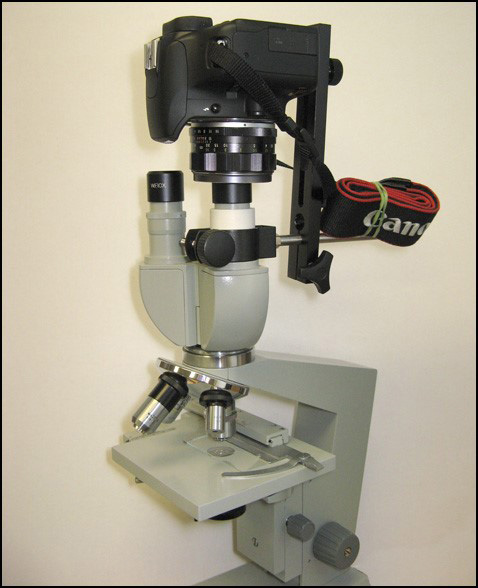Mike,
A bit of background... Pointing a camera and lens down the eyepiece is called the "afocal" technique. As described
HERE, the afocal technique can introduce vignetting due to mismatch between the pupils (apertures) of the eyepiece and the camera lens.
What you've done by using a fully extended 90 mm macro lens on the camera is to zoom in on the central area of the microscope's field of view.
This has the nice effect of filling the frame with a subject that would normally be viewed at higher magnification, while simultaneously reducing the vignetting so that it only cuts off the two bottom corners.
Unfortunately this approach also introduces a couple of not so nice effects. One effect is that you're making the eyepiece focus in a way that it's not intended to, producing its "virtual image" only a few inches below the eyepiece instead of at 16 inches or even farther away. This may introduce some aberrations. The other effect is that by blowing up just the center of the field, you may be encountering "empty magnification" caused by resolution limits in the objective.
If you're going to use the afocal technique, I strongly recommend using a shorter wider lens such as the old SLR lens shown in this image from the thread linked above:

Using the afocal technique, it really doesn't matter whether the objective is finite or infinite, as long as the objective matches the eyepiece and the rest of the scope's optics (if any).
One other thing... I notice on the right side of the image that there's quite a bit of color fringing. I suspect that's being caused (emphasized, anyway) by mismatch between pupils of the eyepiece and the macro lens. The situation is very much like what's discussed in the
FAQ: Stopping down a lens combo, where stopping down the rear aperture causes the image to be formed from bad parts of the front lens.
To get the highest quality image from this sort of subject, my current recommendation would be to use a Nikon CFI Plan Achromat 10x NA 0.25 in front of a telephoto lens as discussed in detail
HERE. These objectives can be commonly found on eBay for around $100, are also available new at less than $250 list price, and should play nicely with telephotos that you already have. Stick that combo on a StackShot rail and you'll have a setup that produces great images and is also fun to use.
Switching subjects to illumination...
Looking at the glare pattern, I don't think your continuous illuminator is making any significant contribution to the exposure. That's typical, even desirable because a) the color balances are probably far different, and b) you want the vibration-freezing effect of the short flash.
However, because the entire exposure is being produced by light from a single source, it's still pretty directional even after passing through that pingpong ball. You could do better by adding some aluminum foil reflectors on the side away from the flash, and perhaps also by surrounding the pingpong ball with a second layer of diffusion a couple of inches out. A piece of paper or matte plastic would work well for that.
I hope this helps. Metallic subjects are always challenging, but you should be able to do better than this.
--Rik
Edit: correct typo

